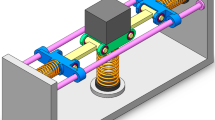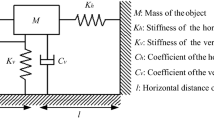Abstract
In this study, the concept of Output Frequency Response Functions (OFRFs) is applied to represent the transmissibility of nonlinear isolators in frequency domain. With the OFRFs estimated from numerical simulation responses, an explicit analytical relationship between the transmissibility and the nonlinear characteristic parameters is derived for a wide class of nonlinear isolators that have nonlinear anti-symmetric damping characteristics and a comprehensive pattern about how the nonlinear damping characteristic parameters might affect the force and displacement transmissibility is built for the vibration isolators. The results reveal that it is reasonable to analyze the force and displacement transmissibility of the nonlinear isolators by simply investigating the fundamental harmonic components of the force and displacement outputs of the nonlinear isolators, and the introduction of a nonlinear anti-symmetric damping into vibration isolators can significantly suppress both the force and displacement transmissibility over the resonant frequency region, but has almost no effect on the transmissibility at non-resonant regions. These conclusions are of significant importance in the analysis and design of the nonlinear vibration isolators with nonlinear anti-symmetric damping.
Similar content being viewed by others
References
Jazar G N, Narimani A, Golnaraghi M F, Swanson D A. Practical frequency and time optimal design of passive linear vibration isolation mounts. Vehicle System Dynamics, 2003, 39(6): 437–466
Alhan C, Gavin H. A parametric study of linear and non-linear passively damped seismic isolation systems for buildings. Engineering Structures, 2004, 26(4): 485–497
Franchek M A, Ryan M W, Bernhard R J. Adaptive passive vibration control. Journal of Sound and Vibration, 1996, 189(5): 565–585
Liu Y, Waters T P, Brennan M J. A comparison of semi-active damping control strategies for vibration isolation of harmonic disturbances. Journal of Sound and Vibration, 2005, 280(1,2): 21–39
Crede C E. Vibration and Shock Isolation. New York: John Wiley, 1951
Soliman J I, Ismailzadeh E. Optimization of unidirectional viscous damped vibration isolation system (for airborne equipment protection). Journal of Sound and Vibration, 1974, 36(4): 527–539
Snowdon J C. Vibration isolation use and characterization. Journal of the Acoustical Society of America, 1979, 66(5): 1245–1279
Ibrahim R A. Recent advances in nonlinear passive vibration isolators. Journal of Sound and Vibration, 2008, 314(3–5): 371–452
Jiang L, Stredulinsky D, Szabo J, Chernuka M W. Numerical characterization of nonlinear stiffness properties of pre-stressed vibration isolation mounts. Canadian Acoustics-Acoustique Canadienne, 2002, 30: 70–71
Nayfeh T A, Emaci E, Vakakis A F. Application of nonlinear localization to the optimization of a vibration isolation system. American Institute of Aeronautics and Astronautics Journal, 1997, 35: 1378–1386
Jazar G N, Houim R, Narimani A, Golnaraghi M F. Frequency response and jump avoidance in a nonlinear passive engine mount. Journal of Vibration and Control, 2006, 12(11): 1205–1237
Lang Z Q, Billings S A, Yue R, Li J. Output frequency response functions of nonlinear Volterra systems. Automatica, 2007, 43(5): 805–816
Peng Z K, Lang Z Q, The effects of nonlinearity on the output frequency response of a passive engine mount. Journal of Sound and Vibration, 2008, 318: 313–328
Jeffreys H, Jeffreys B S. Methods of Mathematical Physics. 3rd ed. Cambridge: Cambridge University Press, 1988
Lin W H, Chopra A K. Earthquake response of elastic SDF systems with non-linear fluid viscous dampers. Earthquake Engineering & Structural Dynamics, 2002, 31(9): 1623–1642
Ruzicka J E, Derby T F. Influence of Damping in Vibration Isolation. The Shock and Vibration Information Center, 1971
Wiener N. Nonlinear problems in random theory. New York: Wiley, 1958
Schetzen M. The Volterra and Wiener Theories of Nonlinear Systems. Malabar: Krieger, 1980
Sandberg I W. A perspective on systems theory. IEEE Transactions on Circuits and Systems, 1984, CAS-31(1): 88–103
Boyd S, Chua L O. Fading memory and the problem of approximating nonlinear operators with Volterra series. IEEE Transactions on Circuits and Systems, 1985, CAS-32(11): 1150–1161
Jones J C P E Y T O N, Billings S A. A recursive algorithm for the computing the frequency response of a class of nonlinear difference equation models. International Journal of Control, 1989, 50(5): 1925–1940
Wang J, Meng G, Feng N, Hahn E J. Dynamic performance and control of squeeze mode MR fluid damper rotor system. Smart Materials and Structures, 2005, 14(4): 529–539
Wang J, Meng G. Magnetorheological fluid devices: Principles, characteristics and applications in mechanical engineering, PIME, Part L. Journal of Materials: Design and Applications, 2001, 215: 165–174
Author information
Authors and Affiliations
Corresponding author
Rights and permissions
About this article
Cite this article
Peng, Z.K., Lang, Z.Q. & Meng, G. Evaluation of transmissibility for a class of nonlinear passive vibration isolators. Front. Mech. Eng. 7, 401–409 (2012). https://doi.org/10.1007/s11465-012-0349-9
Received:
Accepted:
Published:
Issue Date:
DOI: https://doi.org/10.1007/s11465-012-0349-9




